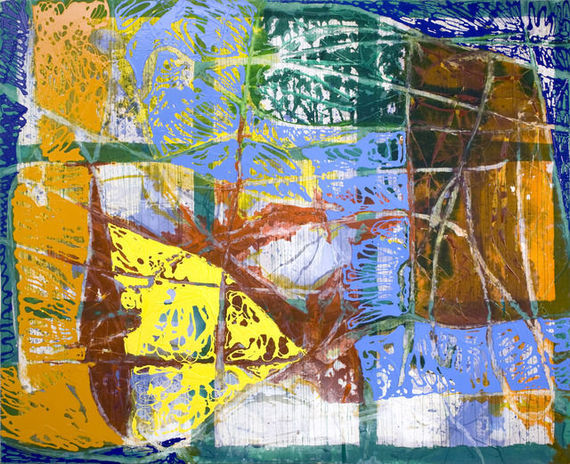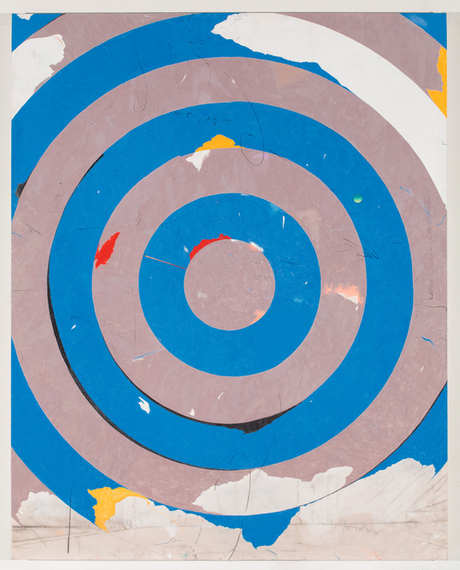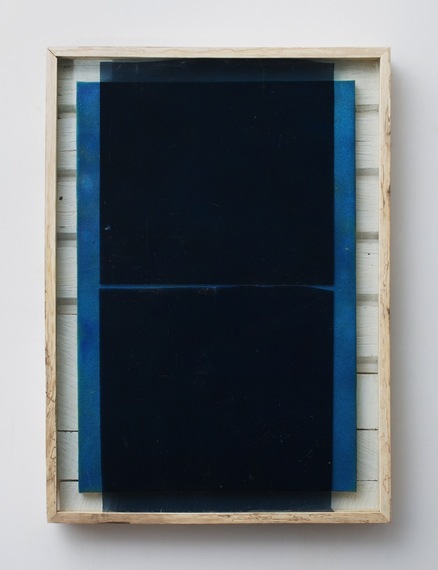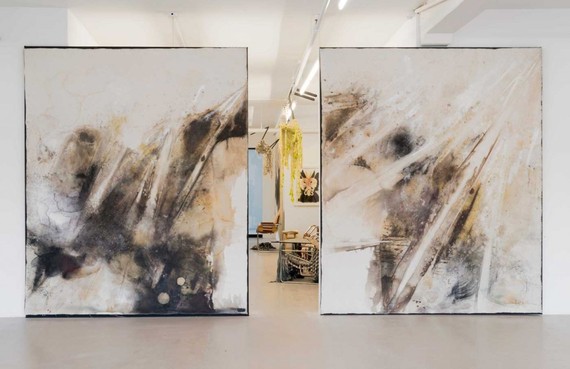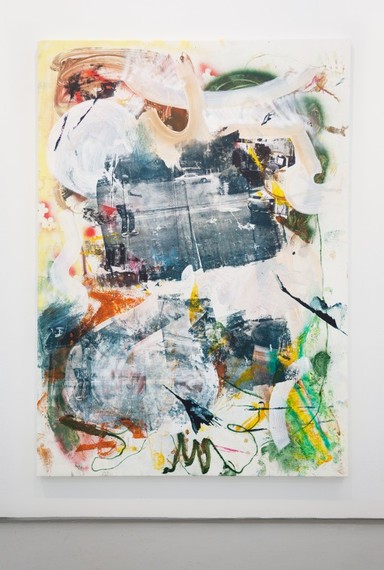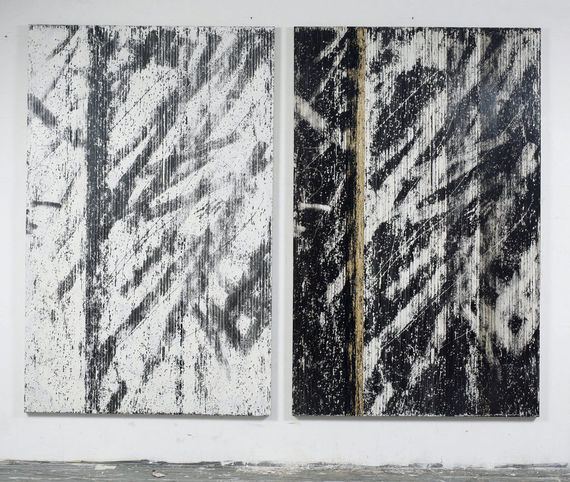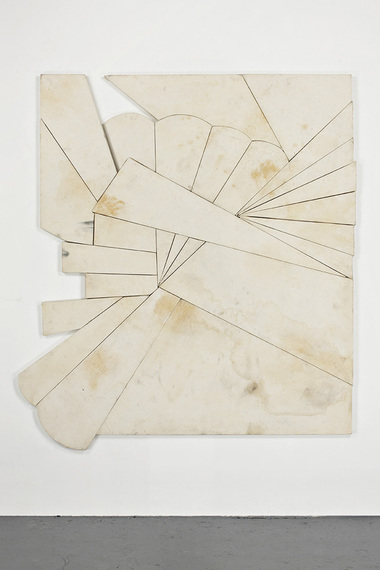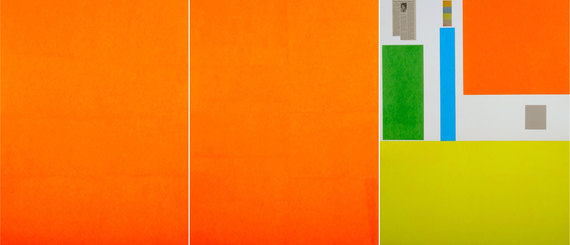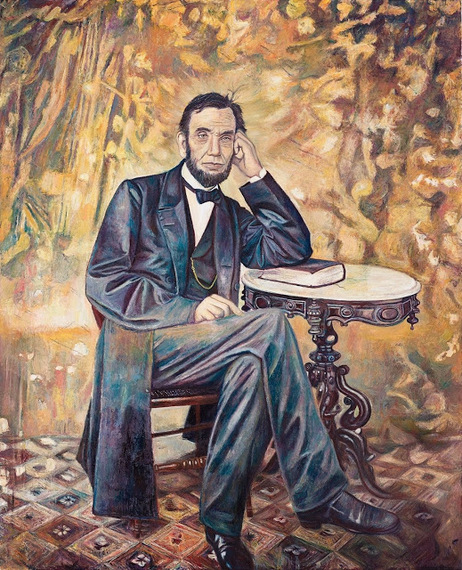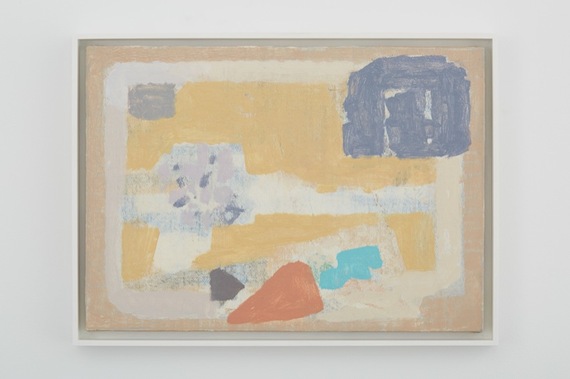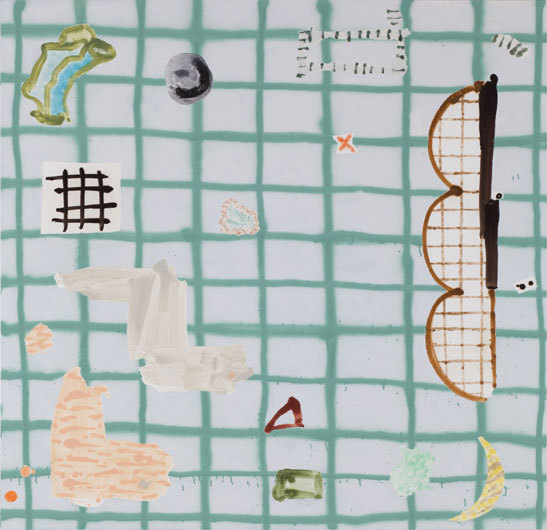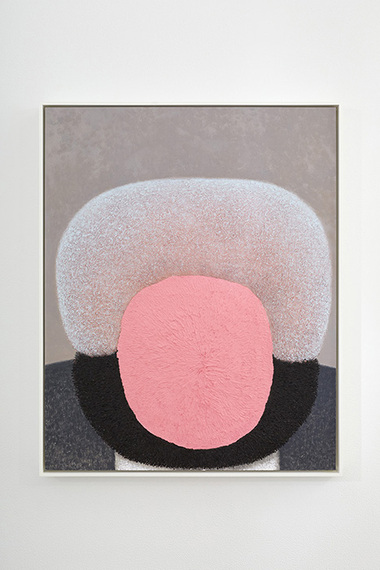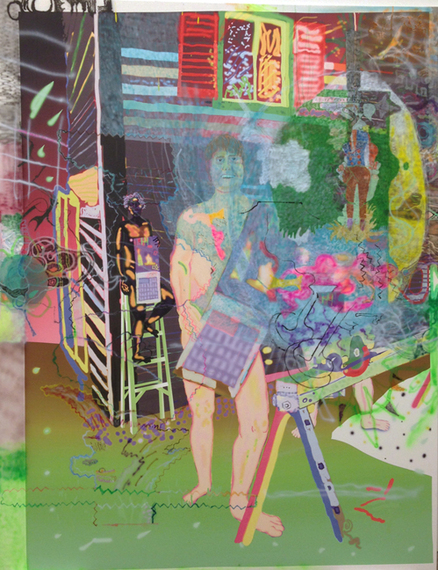Artists kept making paintings in 2013, and they did so in ever more inventive ways. If any single word can sum up the overriding concern of many younger artists over the past few years it is process. As of late, many painters have defined themselves not so much with a specific image or style, but with the way in which they go about "producing" their work. Fire extinguishers, bleach, the sun, printing technologies and even spaghetti have all been employed in the quest for aesthetic advancement. For these artists, the way in which an artwork is made becomes deeply embedded in the meaning of their work. The results of such technical explorations can occasionally come of as gimmicky, but, when successful, they can lead to extraordinary art and new ways of thinking about the medium of paint.
What does painting hold for 2014? If a quick survey of upcoming museum shows, including the 2014 Whitney Biennial is any indication, it will be more widely exhibited and talked about than ever, and mature artists such as Dona Nelson (a 2012 Painters to Watch pick) and Suzanne McClelland will, more and more, have their long overdue day. I will also go out on a limb and say that, after several years where abstraction has been the dominant language of painting, representational work will start to mount a comeback. Among the hundreds of artists I consider each year while publishing New American Paintings, I have noticed a considerable uptick in the number of young painters working with recognizable imagery, some in, dare I say it, almost traditional modes. (And yes, I am aware that representational painting never left, but the institutions that make up the so-called art world have been preoccupied with other things in recent years.)
Over the past year I conducted dozens of studio visits, traveled to numerous art fairs, and saw hundreds of gallery and museum shows. The list of Painters to Watch in 2014 is made up of some new discoveries, a few artists who, in my mind, presented breakout work this year, and a few old favorites who deserve wider attention. For the purposes of this list, I am defining the activity of painting as broadly as possible. Traditional definitions of media have become less and less important for emerging artists, and, no doubt, some of the listed artists would not consider themselves to be painters per se.
Who is on your list?
Gina Beavers:
I first became aware of Gina Beavers' work in a group show that artist and occasional curator Eddie Martinez organized several years ago. I was intrigued then, but it was her late 2012 show at Clifton Benevento in New York that sold me. Beavers is unashamed of the decadent application of paint at a time when many artists are doing as much as possible to negate evidence of the hand and keep the viewer pinned to the surface of their work. There is no attempt to strong-arm the spectator in Beavers' paintings, just a generous offering of visual pleasure. Subject and facture are in perfect harmony with her recent work. I look forward to seeing what comes next.
Armin Boehm:
How do you attract attention in the cavernous Miami Beach Convention Center when it comes time for the annual Art Basel Miami Beach fair? If you are not dedicating your entire booth to a pack of cigarettes being dragged around the floor, or displaying a $10 million Easter egg, the work had better be really good in order to stand out. As I wandered through this year's installment, a number of things caught my eye. One of them was Armin Boehm's figurative paintings at Meyer Riegger. I first saw Boehm's work at the sadly now-closed Harris Lieberman Gallery in New York in 2012 and I liked them. At Miami Basel I really liked them. Along with Dana Schutz, Eddie Martinez and Nicole Eisenman, Boehm is one of the more interesting artists currently working with the figure. He wears his German Expressionist influences on his sleeve, but he is clearly capable of carving out his own visual territory.
Andrew Brischler:
Brischler has been on a bit of a rocket ride over the past year. A New American Paintings' alum, he was featured in the publication just last year as he was finishing an MFA at the School of Visual Arts. Since then, he has been taken on by Gavlak Gallery in Palm Beach, who most recently gave him prominent exposure in their Art Basel Miami Beach booth, and has been exhibiting internationally. Brischler is a student of the history of abstract painting, and apparently he has been taking very careful notes. Whether he is working with hard-edged forms, staining canvas or demonstrating his gestural chops, Brischler evinces amazing fluency with a range of techniques. With such a variety of influences feeding his work, one might think that Brischler is engaged in an intentional critique of abstraction, but to my eye his paintings seem more about an unabashed love of paint. Definitely one to watch.
Graham Collins:
Graham Collins' work is relatively new to me. I saw his show at Halsey McKay Gallery in East Hampton last summer and I was hooked from the get-go. The work, which straddles the line between ruin and stability, has true presence. Combining monochrome painting, scrims of glass and salvaged wood, Collins sets up a situation where viewers at first encounter a minimalist object, then discover all manner of unexpected nuance, and ultimately, through reflections, become keenly aware of themselves and the act of viewing. His work looked great in The Journal's booth at the Nada Miami Art Fair, and it seems that collectors agreed. Rumor has it that there is now a substantial waiting list for the young artist's work.
Lucy Dodd:
I was aimlessly wandering around the Lower East Side several weeks ago while waiting to meet a friend for lunch. I decided to pop into the David Lewis Gallery, which I had never heard of. On display was a cacophonous installation of paintings and objects/sculpture by an artist I had never heard of: Lucy Dodd. Every once in a while you make an unexpected discovery. Dodd uses a range of nontraditional materials in her paintings, which are at once out of control and perfectly composed. Critic Jerry Saltz too found a lot to like in the show. In a particularly rhapsodic review, Saltz stated: "Dodd's work widens the senses, makes the cosmic thickening visible, and uncrumples something fundamental." Whoa...enough said.
Leo Gabin:
The European artist collective Leo Gabin -- composed of Lieven Deconinck, Gaetan Begerem and Robin De Vooght -- was a relatively unknown quantity in the States until New York gallerist Elizabeth Dee mounted a show earlier this year. In Europe, the group had already gained a lot of attention over the past few years. Working exclusively as a collective since 2000, Leo Gabin mines the Internet for subject matter. Their work addresses a multitude of issues arising within our increasingly digital culture, and potently critiques the status of authorship.
Gregor Hildebrandt:
Gregor Hildebrandt is an artist who has been well known in Europe for over a decade, and has yet to make a splash in the States. With a soon-to-open show at Gallerie Perrotin's stunning New York space, that is sure to change. Hildebrandt's paintings are complex, both in their facture and meaning. The artist makes use of pre-recorded cassette tapes in much of his work. Applied directly to the canvas, the tape acts as a powerful formal device; more importantly, though, because of its original function as a storage device, it adds layers of hidden meaning to the paintings. While Hildebrandt is well aware of the ways in which his work references minimalism, he is ultimately interested in a much more personal content.
Wyatt Kahn:
A 2012 graduate of Hunter College's sizzling hot MFA program, Kahn's work came to my attention at Rachel Uffner Gallery in New York earlier this year in the context of a two-person show. He arrives at his jigsaw-puzzle paintings by reassembling a larger canvas he has cut up. At a distance, Kahn's work reads as sculptural. On closer inspection, however, you can see that it registers a subtle, but visually complex, use of color. There is a certain instability latent in his pictures...as if they could fall apart at anytime. Kahn is clearly aware of his predecessors' attempts to wrestle with shape and the picture plane, but there is a lot more going on his paintings than structural gymnastics. I am excited to see how his work will develop.
David X. Levine:
In the interest of full disclosure, I have worked with David in the gallerist part of my life for more than a decade. So sure, with this pick I am heavily biased. Even so, I say this with all seriousness: you will find VERY few artists who work as hard and whose work comes from as genuine a place as Levine's. Chiefly using colored pencil on paper and collage at a scale that, given his chosen medium, could be referred to as monumental, he has an intuitive sense of form and color that is simply astounding. To his credit, he has steadfastly pursued his own unique vision as myriad trends have washed over the art world. Levine is ultimately concerned with establishing an unmediated, direct connection with the viewer, and he succeeds at this in a way that few do. As of late, a younger generation of artists has started to take notice of his work, and the hip artist-run space Know More Games in Brooklyn has been actively promoting him.
Keith Mayerson:
A mid-career artist, Mayerson has been actively exhibiting since the early-1990s, and will be featured in the 2014 Whitney Biennial. He was also the cover artist for the 2007 Northeast issue of New American Paintings. A representational painter, but not a realist, Mayerson has traditionally drawn his subject matter from media sources. His style of painting has had all manner of description attached to it over the years, including "thrift-store," which is to say that at first glance his work may seem slap dash. Something has been happening as of late though. The paintings in his 2013 show at Derek Eller Gallery in New York just seemed more intense and cohesive, both in terms of execution and subject matter. When I visited Eller's booth at the Nada Miami Art Fair, I found Mayerson's painting of Abraham Lincoln to be one of the best pictures I had seen in all of Miami.
Sarah McEneaney:
There are underrated artists and then there are ridiculously underrated artists. Sarah McEneaney falls into the latter group. I am not overstating it when I say that she is one of my favorite painters working today. Her ability to construct space gives her intimately scaled egg tempera paintings a shocking immediacy. McEneaney is an artist who is not afraid to let the viewer into some very private places. It might be tempting to lump her in with the widespread trend of faux-naïve that has been pervasive in the last decade, but there is nothing "faux" about her paintings. My sense is that there is no strategic impulse at work at all. McEneaney's pictorial language simply is what it is, and it can be no other way. Look for a 2014 solo exhibition at Tibor de Nagy Gallery in New York.
Ryan McLaughlin:
Ryan McLaughlin's soon-to-close show at Laurel Gitlen in New York is one of the best painting shows I saw in 2013. This guy can paint, and he clearly has a deep respect for his medium and the practitioners who have come before him. Pictorial space has been an issue that painters have wrestled with for centuries. As the 20th Century dawned and artists increasingly embraced the essential "flatness" of paintings, the subject itself became increasingly intrinsic to the content of their work. Jasper Johns cheekily sidestepped the issue by choosing to paint subjects that were flat to begin with. McLaughlin chooses similar subject matter. Unlike Johns' paintings, however, McLaughlin's do not read as a sort of conceptual game. Yet, like Johns, McLaughlin has an amazing ability to attend to every inch of canvas in way that imbues even the most minor gesture with a necessary place within the larger whole.
Rebecca Morris:
Hawaiian-born Rebecca Morris has been actively exhibiting since the mid-1990s; I guess it is fair to say that she is a mid-career painter. Her inclusion in the upcoming 2014 Whitney Biennial is well deserved, and sure to generate a lot of new fans. Morris is, and always has been, very much a painter's painter. Like Amy Sillman and Charline Von Heyl, she displays the kind of formal inventiveness that simply can't be taught...you either have it, or you don't. Morris' large-scale paintings exhibit a sensitivity to the medium that is rare. At the end of the day, her work is simply stunning to behold.
Lui Shtini:
How can you forget a name like Lui Shtini? Somehow the name had slipped my mind after seeing his work several years ago at the tony uptown Van de Weghe gallery. Maybe it was the context, after all, said gallery's programming is really dedicated to blue chip artists, and I am rarely there. What I remember from that show are quirky and extraordinarily well executed paintings. In late November I walked in to Kate Werble's downtown New York space and there was that name again. The work on view still demonstrated a high level of technical facility, but technique had yielded primacy to raw immediacy. Shtini's "portraits" having nothing to do with verisimilitude and everything to do with an artist expanding the potential of his medium, while simultaneously injecting new life into the well trodden space of portraiture.
Jesse Willenbring:
Jesse Willenbring is another Hunter College grad who is starting to make a lot of waves. His paintings embody a series of dichotomies: painterly versus graphic, sincerity versus irony, gravity versus levity. Like other painters on this list, Willenbring is fluent with the history abstraction, and he borrows freely from its tropes. By the time he finishes a painting, however, it is difficult, if not impossible, to identify any direct references; the viewer is left with the slightest scent of the sources and information buried under the strategically obfuscated surfaces. Willenbring's work will be on view at Art Los Angeles Contemporary with Thomas Duncan Gallery in late January, and with Locust Projects in Miami later in 2014.
Michael Williams:
I have loved Williams work ever since first seeing it at New York's Canada gallery in 2007. In subsequent shows, he kept looking better and better. In his just-closed show at Canada, all the parts came together to make for one of my favorites shows of 2013. Being surrounded by Williams' eleven large paintings was a pleasure, and a challenge. His paintings are manic. Executed with inkjet and airbrush on canvas, he offers the viewer no time out - it is even difficult to grasp where the surface of these paintings begins and ends. Couple Williams' painting technique with his fervent graphic sensibility and you get some very potent and memorable work.
Other painters to look out for in 2014: Chuck Webster, Tony Lewis, Brian Sharp, Davina Semo, Miriam Cahn, David Renggli, Aaron Bobrow, John Dilg, Brenna Youngblood, Sarah Awad, Molly Zuckerman-Hartung, Mark Hagen, James Hyde and Phil Wagner.
Artists from past Watch lists who continued to push it forward in 2013: Eddie Martinez, Matt Connors, Dianna Molzan, Alex Hubbard, Hugh Scott Douglas, Analia Saban, Joshua Abelow, Richard Aldrich, Paul Cowan, Scott Olson and Noam Rappaport.
Emerging artists working in other media that I am currently obsessed with: Shannon Ebner, Eileen Quinlan, Valerie Snobeck, Sarah Braman, Darren Bader, Colin Snapp, John Sparagana, Fredrik Vaerslev, Oscar Tuazon, Pae White, Sam Lewitt, Nick Relph, Tony Matelli and Ricky Swallow.
New American Paintings magazine is a juried exhibition-in-print, and the largest series of artist competitions in the United States. Working with experienced curators, New American Paintings reviews the work of thousands of emerging artists each year. Forty artists are selected to appear in each bi-monthly edition, many of whom go on to receive substantial critical and commercial success. Additional content focuses on the medium of painting, those who influence its direction, and the role contemporary painting plays within the art world. Visit New American Paintings for more information or to subscribe.
